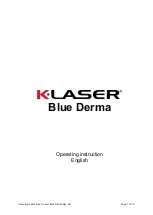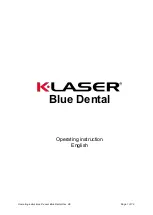
EMTEK, LLC - R100 USERS MANUAL / AUG2019.REV01
6
2.5 R100 Technical Description
The R100 (EMTEK, LLC Remote 100) is a stationary, AC power operated, microbial air sampler. The unit utilizes its’ rear
sanitary inlet connector to connect to various lengths of tubing for remote sampling purposes, making it ideal for filling lines,
BFS, laminar flow hoods, biosafety cabinets, final filtration suites, etc. The unit is comprised of an enclosure and base cover
that are made of grained 316 stainless steel. The 316 stainless steel used to form the enclosure and base plate is ideal for any
testing environment as it will not shed particulates, will resist oxidation, and is impervious to various routinely used chemicals
and cleaning agents. The user interfaces with the R100 through a bicolor LCD touch screen for entering user defined sample
parameters and for the initiation and termination of sample runs. During operation the LCD displays key sample run
information, as well as a visual sample progress indicator.
The R100 is offered with two (2) sample flow rates (requires remote sampling head for operation): 28.3 LPM (1 CFM) and
100 LPM. The highest flow rate, 100 LPM, allows for the collection of a cubic meter of air in 10-minutes, while the 28.3
LPM (1 CFM) flow rate takes approximately 35 minutes to capture a cubic meter. At the 100LPM flow rate the R100 is capable
of sampling with a maximum tubing length of 10 feet (3 meters), while at the 28.3LPM flow rate the R100 is capable of
sampling with a maximum tubing length of 50 feet (15 meters). The flow is controlled through a proprietary CPU control
system, which offers automated flow control of the two defined flow rates. Flow rates are calibrated and set against traceable
standards using an external software program and may not be altered through the user interface on the unit. Sample rates and
total volume sampled maybe displayed and output in Cubic Feet, Liters, or Cubic Meters (only for total volume). Flow alarm
settings are available for the flow rates, which will produce both an audible and visual alarm during operation and may be
output to the optional printer upon completion/termination of the sample period. Alarm occurrences are maintained within
the systems internal memory with the associated sample parameter information until the 500-sample run memory buffer is
cleared.
The R100 operates in conjunction with the RAS with separate sieve impaction inlet covers for each of the two flow rates, 28.3
LPM (1 CFM) and 100 LPM. The RAS is sold in both Anodized Aluminum, and 316SS. The R100 Package can be ordered
with either option, and additional RAS samplers, or inlet covers may be ordered separately. The inlet covers include a 300-
hole pattern with appropriate inlet hole sizing for each flow rate to assure optimal physical and biological recovery capabilities.
Each inlet cover includes a distance gauge, which works in conjunction an adjustable media stage to assure an ideal distance is
maintained between the inlet cover and test media surface for appropriate microbial particulate capture. The air sampler uses
standard 90mm agar based microbial test plates (e.g., Trypticase Soy Agar (TSA)). During testing the sampled air volume
drawn through each air sampler is HEPA filtered before being exhausted within the R100.
The R100 software, allows for sampling periods of up to 120-minutes (or 120 Cubic Feet/3396 Liters/3.4 Cubic Meters) at the
28.3 LPM sample rate, while sample times are limited 30-minutes (or 106 Cubic Feet/3000 Liters/3 Cubic Meters) at 100 LPM.
While the stated time periods, or total sample volumes are allowed by the R100, EMTEK strongly suggests that all sampling
periods employed by be qualified by the user to verify appropriate organismal recovery. In addition, the R100 offers the user
the capability of entering an initial sample delay, as well as hold and test periods for each sample run. This initial sample
delay allows the user time to exit the immediate area of the sample location, while the hold and test period settings allows for
intermittent sampling of an area or process for an extended time period, as determine appropriate by the user. For an example,
the user may set an initial delay period of 3-minutes and then opt to sample for 5-minute periods with 5-minute hold periods
between each 5-minute sampling period, which will occur for a period up to the maximum total sampling period defined for
the flow rate chosen. If the flow rate chosen is 28.3 LPM, and the maximum active sampling period set is 60-minutes, this







































